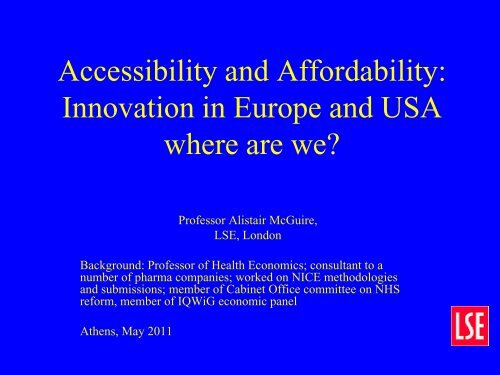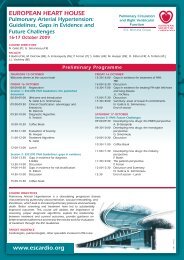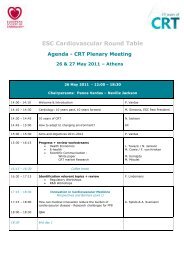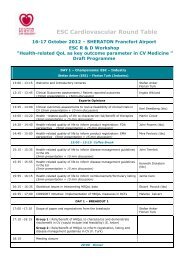Affordability and Accessibility
Affordability and Accessibility
Affordability and Accessibility
- No tags were found...
You also want an ePaper? Increase the reach of your titles
YUMPU automatically turns print PDFs into web optimized ePapers that Google loves.
<strong>Accessibility</strong> <strong>and</strong> <strong>Affordability</strong>:Innovation in Europe <strong>and</strong> USAwhere are we?Professor Alistair McGuire,LSE, LondonBackground: Professor of Health Economics; consultant to anumber of pharma companies; worked on NICE methodologies<strong>and</strong> submissions; member of Cabinet Office committee on NHSreform, member of IQWiG economic panelAthens, May 2011
% GDPLevelsHealth Expenditure as a % of GDP18.016.014.012.010.08.06.04.0CanadaUSAUKFranceGermany2.00.01960196419681972197619801984Years19881992199620002004
GDP vs Health Care Levels: 2006Health expPer capita$US PPPsHealth Expenditure vs GDP2006: R 2 =0.83800070006000500040003000200010000USALuxTurkey0 10000 20000 30000 40000 50000 60000 70000GDP per capita $US PPPs(OECD, 2008)
Health expenditure growth versus GDP GrowthTotal health expenditure per capita(US$ PPP)Compound annual rate of growth1970-1975 1975-1980 1980-1985 1985-1990 1990-1995 1995-2000 2000-2005France 13.5 12.4 9.3 7.2 6.6 3.8 6.3Germany 16.2 11.2 7.7 4.7 5.2 3.4 4.5UK 12.9 9.8 8.1 6.8 6.9 6.1 7.9USA 11 12.6 10.6 9.2 5.9 4.6 7Canada 9.8 10.2 10.1 6.6 3.4 4.1 6.6GDP per capita (US$ PPP) Compound annual rate of growth1970-1975 1975-1980 1980-1985 1985-1990 1990-1995 1995-2000 2000-2005France 9.7 10.2 6.5 6.3 3.2 4.3 3.2Germany 8.8 11 6.9 5.9 1.1 3 3.8UK 8.6 9.1 7.2 6.3 3.9 5.2 5.2USA 8.5 10.1 7.6 5.6 3.6 4.6 3.9Canada 9.5 10.0 7.0 4.7 3.0 4.5 4.3Health care expenditure growth > GDP growth in ALL OECD; except Finl<strong>and</strong>2005-20076.04%4.41%3.52%5.41%5.43%4.88%4.80%4.69%4.28%4.42%(OECD, 2008)
Healthy life expectancy at birthDiminishing returns to expenditure?Healthexpenditure <strong>and</strong> health outcomes80.0075.00JapanGermany70.0065.00CubaChinaCzechUKUKUSAUSA60.00China55.0050.0045.0040.00IndiaEquatorial GuineaNamibiaIndia35.00Lesotho30.00$0.00 $500.00 $1,000.00 $1,500.00 $2,000.00 $2,500.00 $3,000.00 $3,500.00 $4,000.00Health expenditure per capita ($ PPPs)
Decline of major killersSource: UK ONS, 2006Source: Deaton, 2004
BasicProcedureResults
BasicProcedureResults
BasicProcedureResults
198519861987198819891990199119921993199419951996199719981999Percentage of Heart Attack Patients who Die within 30 Daysof Heart Attack, 8 countries 1985-199935%30%25%20%15%10%5%0%AlbertaDenmarkFinl<strong>and</strong>IsraelOntarioPerthQuebecSwedenScotl<strong>and</strong>BasicOutcomesResults50%40%30%20%10%0%Share of Heart Attack Patients who are Readmitted withCardiac Diagnosis within 1 Year of Hear Attack19851986198719881989199019911992199319941995199619971998AlbertaDenmarkFinl<strong>and</strong>OntarioPerthQuebecSwedenTaiwanUSScotl<strong>and</strong>
Health expenditure: What drives it?• Number of studies consider this• Demography– Some effect but smaller than you think• Regulatory framework• Supply side pressures– Technology a major driver– Somewhere between 30% - 55% of expendituregrowth– A massive spillover effect
Health Care Regulation• Fee-for-service lists(primary care)• DRG pricing of hospitals• Price caps forpharmaceuticals• Licensing ofpharmaceuticals considers– Safety issues– Efficacy issues– Quality issues• Cost-effectivenessanalysis• Relativeefficacy/effectiveness
DRGs contd.• DRG prospective payment system can becomplemented by competition for funds– Nash equilibrium game under asymmetry ofinformation using yardstick competition to push P=AC(possibly P=MC)• Practical difficulties – but that‟s the real world; allregulation incurs costs• As DRG plus competition is a risk-sharingpayment scheme pushing P=AC new technologyhas to be regulated too– HTAs <strong>and</strong> cost-effectiveness analysis
Existing research: empirics DRGs• Evidence from the US Medicare DRG payments, under the ProspectivePayment System (PPS), indicate– reductions in average hospital length of stay (Feder et al., 1987; Newhouse <strong>and</strong>Byrne, 1988; Shen, 2003)– reductions in costs (Cutler, 1995; Shen, 2003)• sometimes with apparent increases in the length of stay of long-stay patients (Newhouse<strong>and</strong> Byrne, 1988)– short term shift of treatment from DRG financed inpatient settings to outpatientclinics which were otherwise financed (Cutler, 1998; Ellis & Vidal-Fern<strong>and</strong>ez,2007; Newhouse <strong>and</strong> Byrne, 1988)– Evidence of patient selection <strong>and</strong> cream-skimming was found by• Newhouse (1989) patients in unprofitable DRGs were more likely to be found in„hospitals of last resort‟ suggesting patient selection by profitability• Meltzer et al. (2002) who found greater cost decreases for high cost patients than low costpatients, mirrored by a pattern of reductions in more expensive DRGs• Ellis & McGuire (1996) identified, under Medicaid‟s mental health services in NewHampshire where expenditures for the sickest patients were reduced under prospectivepayment– Little evidence of DRG creep• Carter et al. (1990) investigated changes in Medicare‟s Case Mix Index between 1986-1987 found no evidence to support DRG creep or upcoding
Existing research: Regulated Competition <strong>and</strong> outcomes• Studies with variable prices (so not surprising) competitioneffect on outcomes mixed– USA– UK• Gowrisankaran <strong>and</strong> Town (2003), Ho <strong>and</strong> Hamilton(2000) Sari (2002)• Propper et al (2004, 2008) hospital quality fell (AMI 30-day mortality)• Studies of fixed prices show (quality) competition improvesoutcomes– USA– UK• Shortell <strong>and</strong> Hughes (1998) Kessler <strong>and</strong> McClellan (2000) Shen(2003) Kessler <strong>and</strong> Geppert (2005)• Cooper et al (2010) Gaynor et al (2010) hospital quality (AMI 30 daymortiality rate) improved
Institutional context• DRG (fixed price) reimbursement reduces LoS,plus competition improves hospital quality• New technology not automatically incorporatedwithin DRG• Require HTA arguments– Cost-effectiveness analysis (CEA)
Pharmaceutical market value (ex manufacturersprices € 2004)Source: UK OFT, 2007
Sources of funding forpharmaceuticals 2004-2006Source: UK OFT, 2007
Overview of different Price <strong>and</strong> reimbursement system3 main types: reference pricing, profit control, costeffectivenesspricingIRP – International Reference PricingPVA – Price & Volume AgreementsSource: UK OFT, 2007
Economic evaluation always involves a comparativeanalysis of alternative courses of actionCosts AProgramme AOutcome AChoiceCosts BProgramme BOutcome BThe difference in costs is compared with the difference inoutcomes, to assess the cost per unit of outcome of theintervention of interestICER = (C A – C B ) / (E A – E B )
CostsCost-effectiveness PlaneHigherNew TreatmentWorseComparatorBetterOutcomesLower
BACKGROUND TO THEEUROPEAN SITUATION• Variety of approaches to assessment, drug pricing<strong>and</strong> reimbursement• Great diversity in health care systems• Increasingly formal requirements for economicevaluation• On occasion industry has set the st<strong>and</strong>ard bypresenting economic data
European overview: Pricing &reimbursement• „NICE-like‟ jurisdictions– Sweden, Netherl<strong>and</strong>s, Norway, Irel<strong>and</strong>, Belgium, plussome of Eastern Europe– Cost Effectiveness Analysis• Jurisdictions posing important challenges– France, Germany• Jurisdictions with uncertainties over what isrequired– Spain, Italy, plus some of Eastern Europe
Specific Country examples• Economic evaluation <strong>and</strong> role in– Germany– France– UK– USA
Germany• Population 82mn• GDP $ 36,000 per head (2008)• Health expenditures (2008)– 10.5% per GDP– Statutory health insurance dominates € 151 bn– Private insurance € 19.5bn• Total pharmaceutical market:– Statutory health insurance dominated– 16% of health expenditure• Health Insurance– Statutory Health Insurance (SHI) 88%– Privately insured 11%; 1% others
Germany• Historical – “Free” Pricing of Drugs• Background– Pharmaceuticals “responsible” for someRegions going over budget– Pharmaceutical expenditure rising faster thanother health care expenditure 2001 by 11%compared to 2.5%)– DRGs used extensively in hospital sector
IQWiG: Institut für Qualität undWirtschaftlichkeit im Gesundheitswesen• Initial legislation– IQWiG should assess the clinical effects of healthtechnologies according to “internationally recognisedst<strong>and</strong>ards of evidence-based medicine”– Based on clinical trials (within Germany)– May include economic evaluation of interventions
IQWiG: The Future• IQWiG is clinically dominated• With recent reforms IQWiG will undertake <strong>and</strong> consider clinicalevidence on new technologies• Relative therapeutic advantage to be shown• No relative efficacy price caps• Relative efficacy shown price negotiations will be initiated
German reforms1. Substantial additional benefit• Sustainable substantial improvement: cure, (event free) survival,avoidance of SAE2. Meaningful additional benefit• Clear improvement in patient relevant endpoints3. Small (“geringfügig”) additional benefit• Moderate (not just minor) improvement4. No quantifiable additional benefit• Evidence base not sufficient to establish additional benefit5. No indication of additional benefit6. Negative “additional“ benefit
France• Population 61mn• GDP $ 33,000 per head (2008)• Health expenditures (2008)– 9% per GDP– Statutory health insurance dominates– Private insurance supplements• Total pharmaceutical market:– Statutory health insurance dominated– 15% of health expenditure• Health Insurance– Statutory Health Insurance (SHI) 90%– Privately insured with supplemental insurance 80%
France• Complex system– Framework of agreement• Covers price/volume agreements• Pay-back agreements if volume high• Not transparent
France: ASMR
France• New products– Price set for renewable period of 5 years– Support dossier to be submitted• Transparency Committee – reimbursement• ECHP – pricing to include Economic Evaluation– Volume targets– Positive listing – dependent on reimbursement– CEA being introduced on a more formal basis• Currently use unclear– Post-launch reviews– Negotiation is vital
UK• Population 61mn• GDP $ 35,000 per head (2008)• Health expenditures (2008)– 9% per GDP– Statutory health insurance dominates– Private insurance supplements• Total pharmaceutical market:– Statutory health insurance dominated– 12% of health expenditure• Health Insurance– Statutory Health Insurance (SHI) 90%– Privately insured with supplemental insurance 10%
UK• Current reforms (increase in competition) stalling– But budget cuts in real terms– 40% fall in hospital prices, 20% in productivity sought over 5years• DRG pricing in hospitals• Concern over rising expenditure on new products• Regulation dominated by PPRS– Voluntary profit-capping scheme– “Free” pricing system– Negative list• PPRS will be scrapped (possibly)– NICE currently asks for evidence on cost-effectiveness• €50,000 per QALY– Value based pricing (OFT)– Similar approach for devices (?)
Proposed reforms: VbP• Cost-effectiveness to play a key role– Possibly based on cost-per-QALY but not necessarily• Replacement of one-size fits all threshold with– Basic threshold with costs based on NHS opportunity costs– Higher thresholds where product addresses unmet need• Severity of illness relevant here• Maybe for different indications; thus different prices for same product(?)• Maybe different thresholds for different indications– Higher threshold where product is innovative– Higher threshold where product can illustrate wider societal value
UK VbP• Price setting remains with companies butwill reflect the changed system• CEA thresholds to reflect weightings– Based on evidence• CEA one part of process• Expert panels• Price discussions direct with governmentwill play a critical role
UK• Currently role of NICE being downplayed– Information provider– But depends on NHS reforms• To aid price negotiations• Reform of PPRS coming• More analysis of devices
USA• Population 304mn• GDP $ 46,000 per head (2008)• Health expenditures (2008)– 16% per GDP– Public expenditure 7.3% of GDP– Private expenditure 8.3% of GDP• Total pharmaceutical market:– Statutory health insurance dominated– 12% of health expenditure• Health Insurance– Reforms on-going
USA Health Care Reform• Problems– High % population uninsured (c50m)– High catastrophic payments– High health care costs (the elephant in the room…)• Require most US citizens to have health insurance– Tax penalty for individuals without coverage• some exemptions– Require employers with >50 employees to offer cover• some exceptions– Create state-based American Health Benefit Exchanges• Provide information on plans <strong>and</strong> allow purchase through premiums<strong>and</strong> tax credits
Expansion of US population coverage
Premiums, subsidies <strong>and</strong> other matters• Nongroup policies estimated to rise 10-13% (compared toexisting)– 27-30% rise because of increased benefit coverage– 7-10% reduction due to bigger pools (exchanges), loweradministration costs, increased competition– 57% of individuals would receive subsides• Subsidies to those with income 133-400% of FPL• Subsidies will help limit adverse selection• Employment based market– Small group (
…other matters• Adverse selection in nongroup market/exchanges…may below– Annual open enrolment– Enrolment of broad range of individuals– Subsidies extensive– Reinsurance system for high-cost enrollees limtie premiumincreases• Little on health care costs– Provider responses– Medicare facing banckrupcy – DRG prices may be replaced withprice competition– Unclear what it all means for pharmaceutical prices• More copayment• More restriction• More discounting• More negotiation
…other matters• Dutch system– M<strong>and</strong>atory health insurance through private insurers– Open (annual) enrolment <strong>and</strong> community rating– Risk-equalisation subsidises– Insurers can contract selectively with providers• Problems– Consumer premiums rising– Insurers reporting losses– Patient satisfaction not high– Health care providers cream skimming• Subsidy issues in Mass. USA• Search costs• Political issues– No-one knows where it is currently heading
Conclusions• Regulation increasingly mapped to “Valuebased medicine”• “Free” pricing systems changing regulations• CEA is coming to all in some shape or form• Maybe as an addition to relativeefficacy/effectiveness trend
Conclusions• Innovation facing pressure from– Expenditure constraints– DRG pricing– Value based pricing• HTA/CEA
Where can you help?• Studies– Joint funding at EC level• Surveys– Professional regulation• Data– Uptake/diffusion












